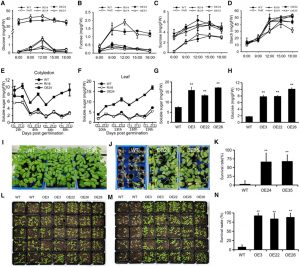Calcium Signaling and Sugar Homeostasis
The calcium sensor Calcineurin B-like protein (CBL) participates in calcium signal transduction by interacting with CBL-interacting protein  kinase (CIPK). CBL-CIPK pathways have been reported to participate in a range of biological processes. In Arabidopsis (Arabidopsis thaliana), there are 10 CBLs and 26 CIPKs that can constitute multiple interaction modules with different affinities. The diversities of expression patterns, subcellular localization, and the downstream targets of CBL-CIPK pathways make the networks flexible and complex. Sugars are the main carbon and energy sources for cellular activities, as well as substrates for cell wall construction and cellular solutes for osmotic balance. In plants, it is necessary to store sugars and distribute them by transporters to maintain a stable supply in sink tissues. In Arabidopsis, there are 79 sugar transporters, including 53 types of monosaccharide transporters (MSTs). Abundant sugar transporters from the three families are localized on the tonoplast membrane to regulate sugar homeostasis. Deng et al. (10.1104/pp.19.01368) describe a CBL2-CIPK6-Tonoplast-Localized Sugar Transporter2 (TST2) molecular module in cotton (Gossypium hirsutum) that regulates plant sugar homeostasis, in particular Glc homeostasis. The authors show that GhCIPK6 is recruited to the tonoplast by GhCBL2 and interacts with the tonoplast-localized sugar transporter GhTST2. Overexpression of either GhCBL2, GhCIPK6, or GhTST2 was sufficient to promote sugar accumulation in transgenic cotton, whereas RNAi-mediated knockdown of GhCIPK6 expression or CRISPR-Cas9-mediated knockout of GhTST2 resulted in significantly decreased Glc content. Mutation of GhCBL2 or GhTST2 in GhCIPK6-overexpressing cotton reinstated sugar contents comparable to wild-type. This enhanced knowledge of the molecular players behind plant sugar homeostasis may be exploited to improve sugar contents and abiotic stress resistance in plants.
kinase (CIPK). CBL-CIPK pathways have been reported to participate in a range of biological processes. In Arabidopsis (Arabidopsis thaliana), there are 10 CBLs and 26 CIPKs that can constitute multiple interaction modules with different affinities. The diversities of expression patterns, subcellular localization, and the downstream targets of CBL-CIPK pathways make the networks flexible and complex. Sugars are the main carbon and energy sources for cellular activities, as well as substrates for cell wall construction and cellular solutes for osmotic balance. In plants, it is necessary to store sugars and distribute them by transporters to maintain a stable supply in sink tissues. In Arabidopsis, there are 79 sugar transporters, including 53 types of monosaccharide transporters (MSTs). Abundant sugar transporters from the three families are localized on the tonoplast membrane to regulate sugar homeostasis. Deng et al. (10.1104/pp.19.01368) describe a CBL2-CIPK6-Tonoplast-Localized Sugar Transporter2 (TST2) molecular module in cotton (Gossypium hirsutum) that regulates plant sugar homeostasis, in particular Glc homeostasis. The authors show that GhCIPK6 is recruited to the tonoplast by GhCBL2 and interacts with the tonoplast-localized sugar transporter GhTST2. Overexpression of either GhCBL2, GhCIPK6, or GhTST2 was sufficient to promote sugar accumulation in transgenic cotton, whereas RNAi-mediated knockdown of GhCIPK6 expression or CRISPR-Cas9-mediated knockout of GhTST2 resulted in significantly decreased Glc content. Mutation of GhCBL2 or GhTST2 in GhCIPK6-overexpressing cotton reinstated sugar contents comparable to wild-type. This enhanced knowledge of the molecular players behind plant sugar homeostasis may be exploited to improve sugar contents and abiotic stress resistance in plants.



